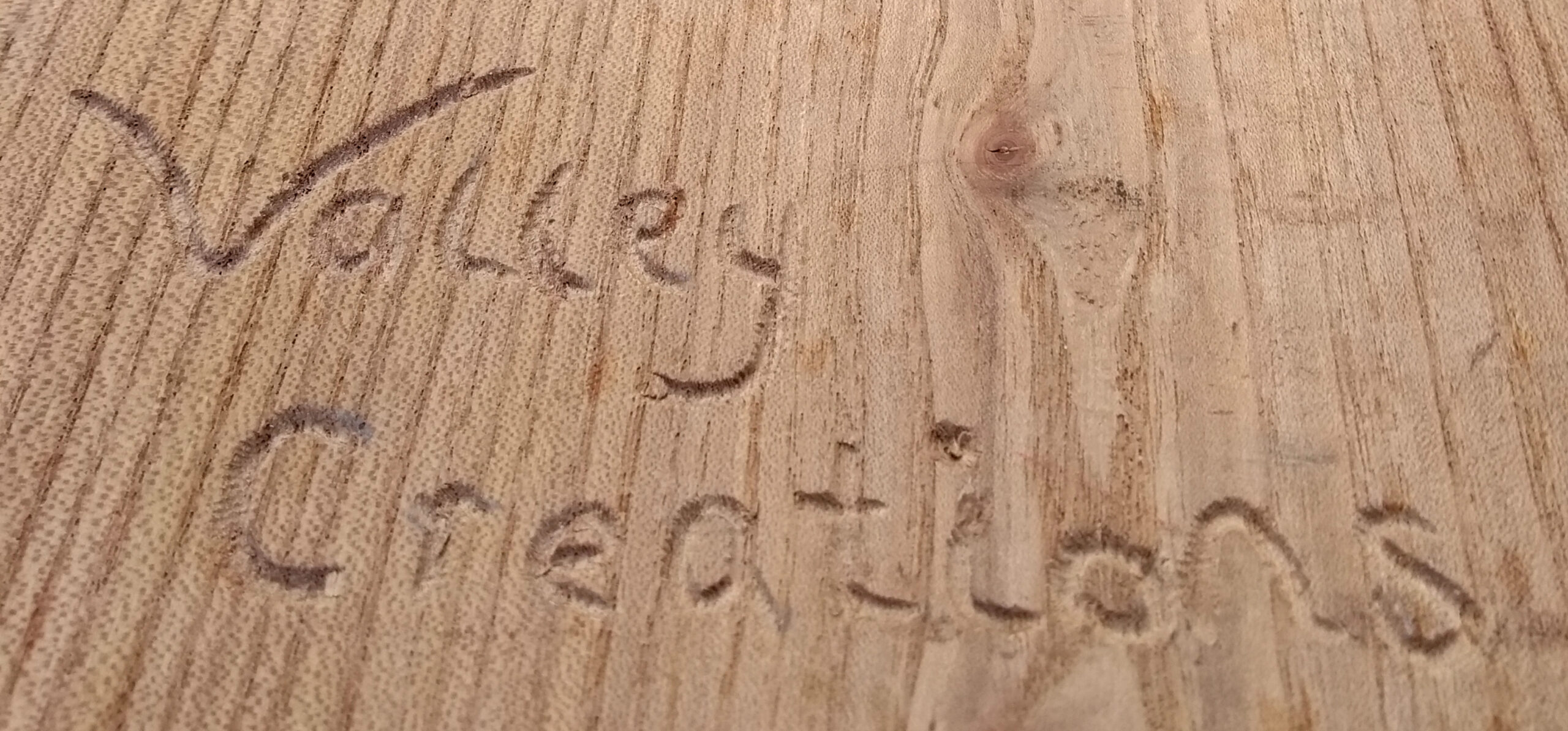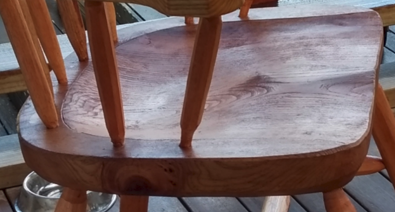Seats, Chair Form and Function
Everyone’s tastes are different, so it is not my intention here to tout a particular style. You will see clearly from these pages the sort of chairs I have been developing. I have mainly stayed with that style because I like it and, more importantly, other people genuinely praise it. That doesn’t mean that these are the only style of chair that I like. A well designed chair is a mixture of form and function and its appeal is not dependent on a particular style. The dining chair I designed for my friend was intended to be completely different, but still seems to work.
When I made my first full chair, which was a rocking chair with arms, I just worked out the geometry based on sitting on the seat, being reasonably cautious about structural strength and what I thought looked good. I also aimed at something lighter looking than many chairs, which are often heavy on the stick numbers. When I put the chair together before gluing, people sat on it to test it out. One of the women on that course sat on it and we both knew straight away that it was a bit tight across the seat for her. When I thought about it I realised that I had measured what I was making against myself (tall and thin), not against a body average or variation on that. I have since heard other women complain that Windsor chairs are often made by men for men. I have one daughter who has long legs and a short body and one who is the opposite, so that started me thinking about the form of the chairs in a new light beyond the width of hips. For comfort chairs, I now try to make the chair fit the person, with heights and widths adjusted subtly to optimise, but also allowing for other people using it. Your challenge if you design chairs is to make them work first and then to make them look good as well. A good carved seat is just wonderful to sit on. People will sit, shuffle contentedly and get a smile on their face, even if you just lay it on a log, so it is a shame to lose that joy by either bad practical design or ugly looks.
Because I didn’t know much about chair making or its history when I made my first chair I was able to let it develop in the way I thought looked good. The result is still pleasing to look at and because my wife has relatively narrow hips, she likes to sit on it too. Because she has shorter legs, she used the footstool shown earlier. That chair and stool are now with my long legged daughter and much loved by her long legged daughter too. The second chair I made, I knew too much. I added more sticks, because a lot of other people did, I made big efforts to make it as wide as possible because the first had been slim. I noticed that people often carved curves under the seat front that matched the ones on the top, so did that. The chair is fine and is a seat of choice for a frequent visitor, but it is a bit of an experimental mix that isn’t as coherent as the first. Each chair since has had some element of experiment and compromise, but I think I have got better at making the whole work well. The decisions you make should reflect the purpose for the chair, the design features you have decided to incorporate and an element of taste in styles.
Before I look at particular chair types, here are some observations from my experiments. I have a chronic bad back that is also relatively long, so I have experimented with a range of back styles and lengths. I have found that good Windsor chairs, with a carved seat that holds you firmly, negate the need for a longer back. While I was visiting Richard Hare he showed me his first rocking chair that had a really high comb back with very thin and long sticks ,that had followed him round for many years and was still functioning on his outside porch. You can make a back as high as you want mechanically, but this prototype dining chair of mine that I am sat on is perfectly comfortable, so you should do the back at a height that you think looks OK.
I mentioned the seat above. Here are two comfortable seats.
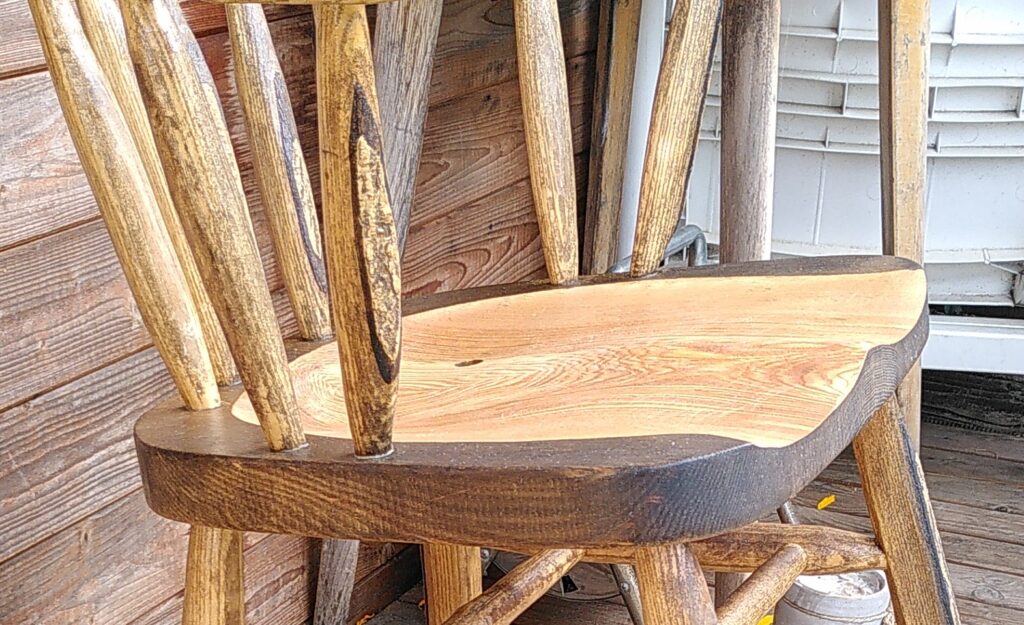
I think many people don’t carve the seat deep enough. It should stop you sliding about without feeling restrictive. If you are worried about going too deep, measure how deep your seat blank is and keep checking by putting a straight edge over the seat and measuring downwards. I think you will be surprised how much wood you can take out and how much you still have left, each time you measure. Because I was carving one seat with a gouge, I decided to do so in a pattern. Peter Murray mentioned that some people leave the pattern, so I did. It is amazing how comfortable a set of raised ridges are, as long as you round them off. They also reduce the risk of sliding about on the seat. This highlights that people often spend too much time worrying about finish. Form and function are much more important.
Here are three more seats, one that you have seen before:

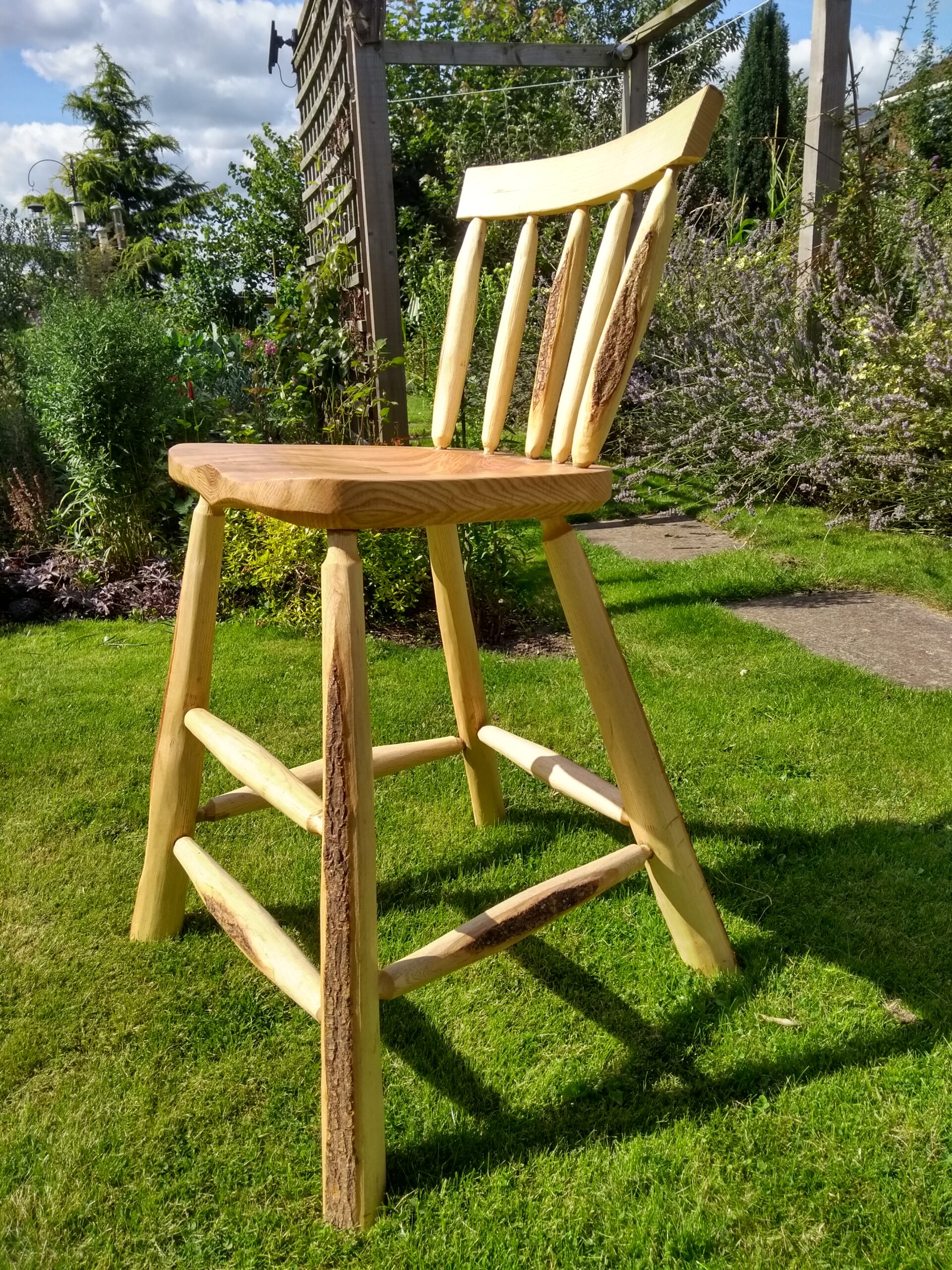
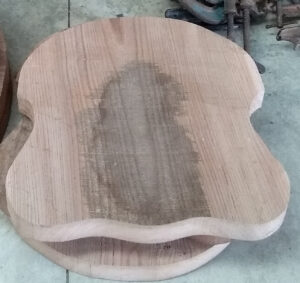

The bar stools on the left still have carved seats, but they are for perching rather than sitting. They only work if you can comfortably get your legs on the ground. They are great for a quick breakfast and crossword. They are really light and tuck completely away. They are so light that we put small strengthening blocks under the seat for the legs.
Ruth’s bar stool can be sat on comfortably by someone of any height. It is so stable that even a small child can climb up. Because it only gets pulled in and out its weight is not a problem. with my experience now, I would make it lighter, but it is still a nice chair.
Next to Ruth’s stool are some diding seat blanks, by Richard Hare. They are shaped to reduce wood and thus weight, as well as look good. Richard carves away the edges radically at the front and sides, reducing weight even more. The wide bit at the back still allows you to carve a fairly comfortable hollow in.
The bottom picture is the dining chair I made during lockdown. The seat is made from 7 different pieces of wood, but they are designed to work together to create strength and stability. The result is a really light chair. The full chair is pictured just further down the page.
Perspective works well on a chair. As mentioned earlier the back legs can be in from the line of the front ones, exaggerating the perspective. Side stretchers can be larger at the front than the back, giving a similar effect.
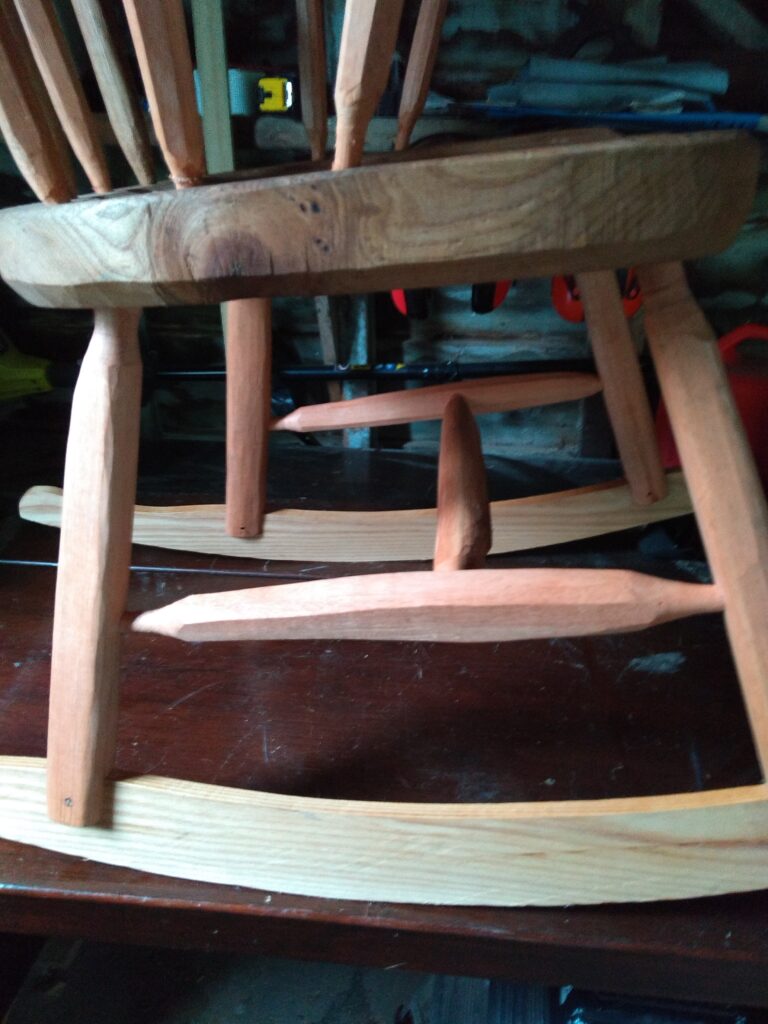
Stretchers do not need to be at the same height. On the bar stool I am sat on at the front, the side stretchers are higher than the lower front one and the back one higher again. You can slope stretchers down slightly from front to back as well. It is often good for backs to be able to tuck your legs back under the seat, so bear that in mind when designing stretchers. When you are looking at features like bark left on or turnings that have been planed either side to make a flatter version, remember that the chair will be looked at from all angles, so walk round it like a sculpture.
A dining chair has some particular features that are dictated by purpose. It should normally be light because it will be moved around a lot and for the same reason it is better if it is reasonably easy to pick up. It will usually be narrow because most of us don’t have huge dining rooms with space for large chairs. It needs to be high enough and upright enough to eat at table comfortably, but not so upright that you can’t enjoy relaxing at the table after the meal. Even with narrow chairs you often have to be able to slide sideways into the chair in a reasonable tight space, so arms that come right to the front of the seat are usually better avoided. The chair normally needs to be able to push under the table partially to allow easy passage behind. If it has arms, they should not interfere with elbows while eating.
My chair designs aim to achieve all of those while giving every chair occupant arms to rest on, rather than just those at the heads of table, as is often the case.
Here the dining chair I mentioned above, designed and made during Covid Lockdown.
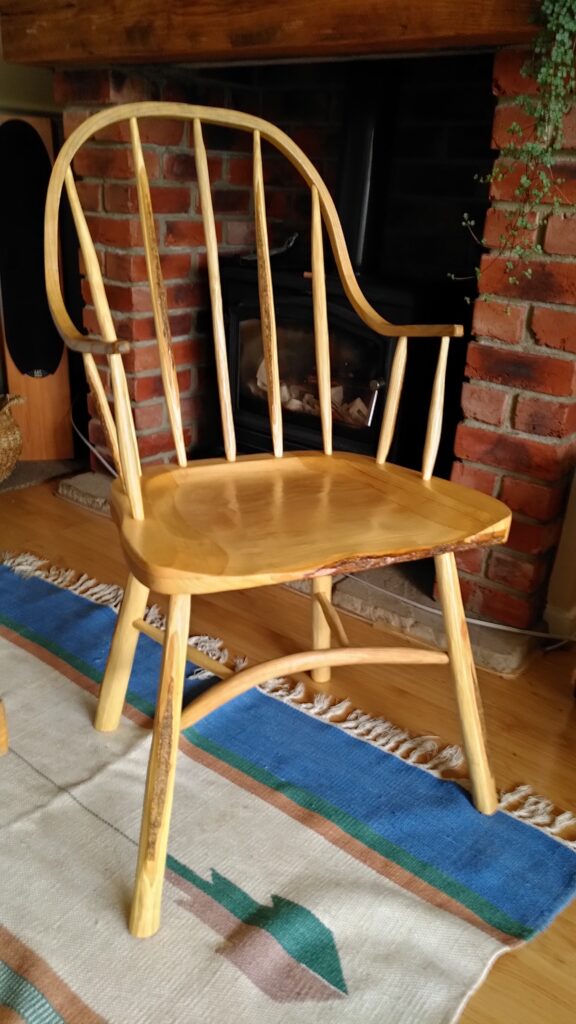
This is was made from odd bits of left over materials during Covid Lockdown. My first double steam bend, first curved stretcher and all a bit uneven. It does cover all the bases listed for a dining chair and it is light and comfortable.
Finally on dining chairs here is one made to match the double bow backed bench shown earlier;
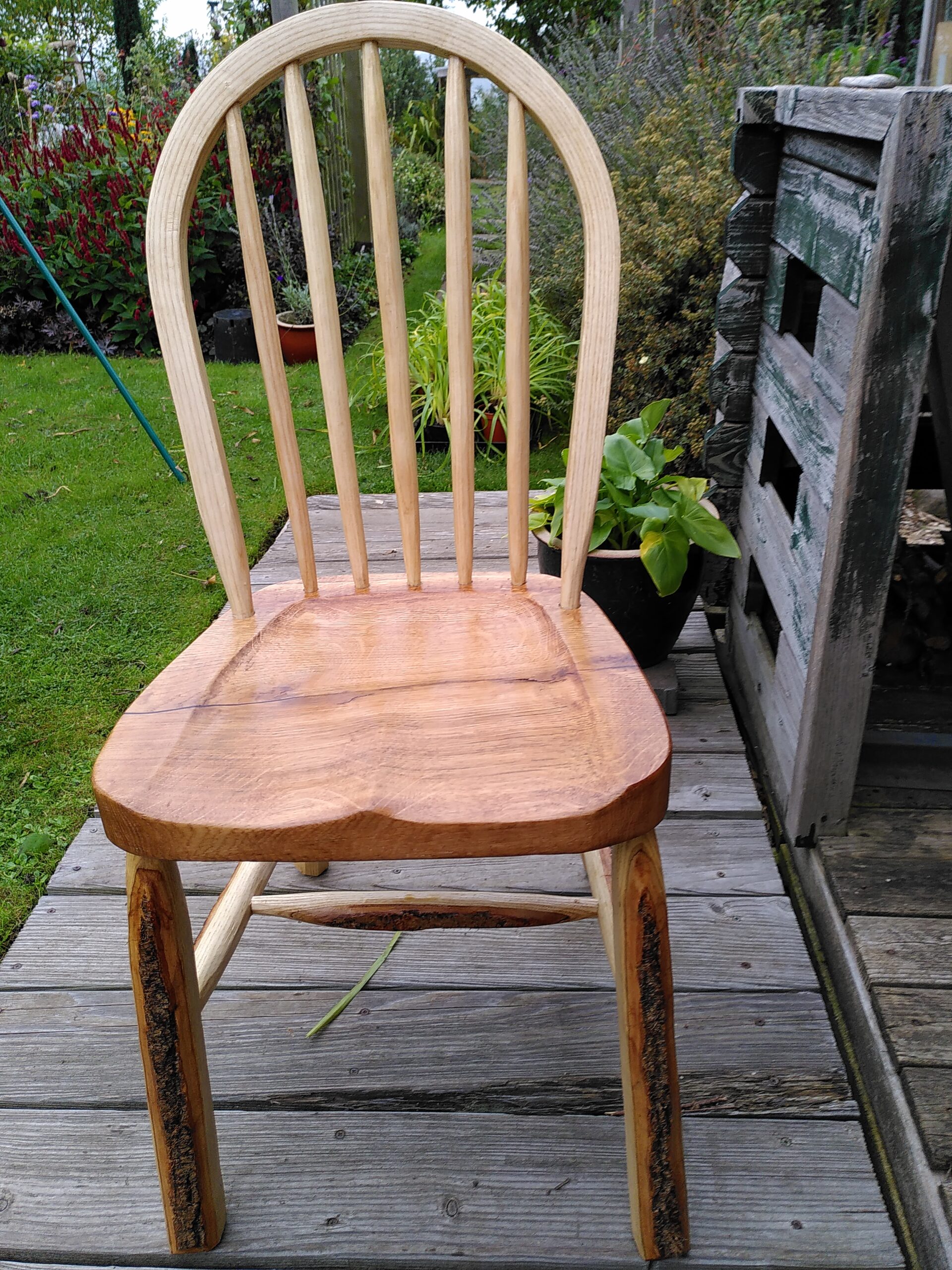
Like the bench, this chair lives outside, under a shelter, during the summer and moves into the shed for the winter. It is a dining chair again, but is heavy and so, hopefully, more resilient to outdoor life. It doesn’t need to be moved each time you sit down, so weight is not a problem.
How should a relaxing chair differ from a dining chair? The answer is probably less than you think. Because it doesn’t have the need to move around as much or to be light, it can be a bit more generous in width. Any arms can be at the most comfortable height without worrying about interfering with elbows and tables. Perhaps it should have slightly more slope from front to back and a lower seat, but actually these are probably not really necessary. I have already written about rocking chairs and these are probably the most comfortable chairs for long term sitting. I suspect most people are not going to give up their comfy settees, but you will probably find it easier to get up again, without an involuntary groan, if you use a good Windsor chair. I will even sanction use of a flat soft cushion, just to make it really luxurious.
Beyond those simple tips I will leave it up to you decide what you like. I prefer simpler forms and think that a lot of more ornate patterns were a product of a battle between bodgers and manufacturers to make chairs lighter, or at least look lighter and to add more twiddly bits, as a way of showing off. Artists and chair makers alike will talk to you of a golden ratio. If you think of a ratio of 3 to 2 it will give you some idea. There is no real point in getting too fussy about what it really is, but if you place your stretchers roughly three units up from the base of the legs and two from the seat, or put three fiddly bits on you legs at the top and two lower down, or make your back length three units down to the arm bow and the arm bow two units from the seat, then you will be following in a tradition of asymmetry that people often find pleasing. I would advise that you just do what you think looks good, as long as it is comfortable and robust.
